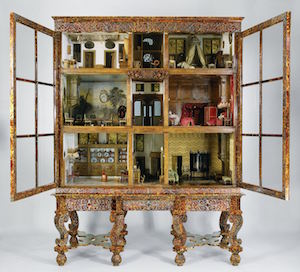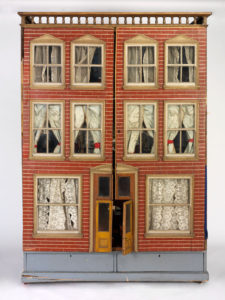
Petronella Oortman’s dolls house (c. 1686-1710), which inspired the story of The Miniaturist. Picture from the Rijksmuseum.
Since reading The Miniaturist by Jessie Burton, and visiting the V&A Museum of Childhood I have been interested in the history of dolls houses. Now, they are mostly seen as children’s toys, and more often girl’s toys, but has that always been the case?
In The Miniaturist, the protagonist, Petronella, is given a miniature house by her new husband as a present. The book is set in seventeenth century Amsterdam, which is where the real history of European doll houses begins. Originally called ‘baby houses’, they were tiny representations of real homes, all proportionally correct and custom made. Houses were not toys, but rather curios and indications of the wealth and taste of a household. In the story, although Petronella is young, she is an adult, and is not expected to play with the house as much as appreciate its craftsmanship. Husbands often gave new brides miniature representations of the bride’s family homes, which was supposed to ease homesickness.
In this way, doll houses were always more often built for girls than boys. They also had a purpose in preparing a girl or young woman for her time overseeing a household, by observing the houses and their equipment and being able to learn their complex roles as keepers of a household.

Image from V&A Museum of Childhood
In the 19th century, the Industrial Revolution made it possible to mass-produce doll houses and miniature furniture. It is during the late Victorian era that doll houses came to be a child’s toy, and wealthy families would regularly have one in the nursery for their child to play with. The switch probably arose from their mass production and the associated drop in production costs. If it wasn’t so expensive, it wouldn’t matter if children played with it and potentially broke it!
Cabinet houses began as trophies for the wealthy of northern Europe. As the cost of production lessened, children were allowed to play with them. I will leave you with this interesting quote on children’s fascination with doll houses:
“It [the doll house] presented a God’s-eye view with its owner as God, rather than merely inhabitant. For the child it is exactly the same but more so. Children lack the control over their everyday lives so the ability to dictate the details of existence in the doll’s house provides a sense of agency.” – Edwin Heathcote writing for the Financial Times, 12/12/2014
-Jocelyn Anderson-Wood
Junior Girl
Girl Museum Inc.
